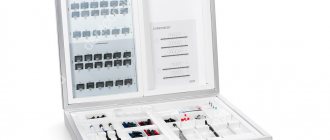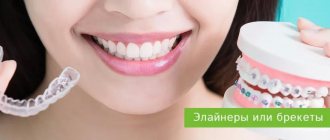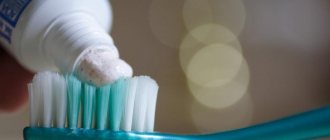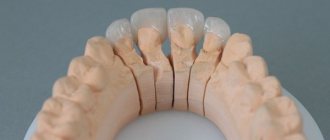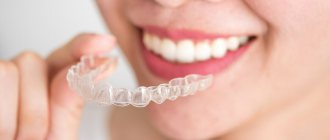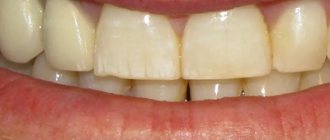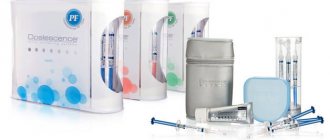| COMMON DATA | ALINERS | BRACKETS | VENEERS |
| What they look like | transparent mouth guards for temporary wear | temporary sticker on teeth + wire | permanent sticker on teeth |
| Color spectrum | transparent | the most diverse | white or the color of the patient’s teeth |
| Material | polymer | metal/polymer/ceramics | polymer/porcelain/ceramics |
| Transparency | Yes | No | Yes |
| Possibility of metal allergy | No | Yes | No |
| Suitable for children under 16 years old | no But the technology is being developed for children from 7 years old. | Yes | not earlier than the formation of enamel of permanent teeth is completed |
Seriously speaking, it is best to be treated with aligners
Yes, I want to book a free consultation on aligners in my city!
If braces and veneers - we all understand that they are visual and what they are, then aligners
- These are the lightest transparent mouthguards made of solid polymer.
When you put on the aligners, you see your entire dentition (the aligners become invisible).
And this is a plus for aligners
Also, the advantages of aligners include the absence of allergies, just like veneers. Braces cannot boast of this.
By the way, you can find out in 1 minute whether aligners are right for you or whether doctors will forcibly offer only braces: you need to answer only 9 express questions
.
But the main general advantage of braces is that they can be installed in childhood. Although, according to the scientific development department of Star Smile, aligners are now being developed for children from 7 years of age. If this works out, then the undisputed leadership in the overall comparison will go to the aligners.
Dental restoration methods
The direct method is the application of a light-curing composite material. The doctor forms a layer, illuminates it with a UV lamp, and so on until he completely restores the shape of the tooth. A rich palette allows you to choose the shade of the composite to match the natural tone of your teeth. Finally, sanding is carried out. The restoration will last up to 5-7 years.
The indirect method is the use of veneers or crowns for chewing teeth. They are made in a dental laboratory from ceramic masses and metal or zirconium frames. Service life – 10-15 years.
Preparation for treatment with braces, veneers and aligners
| Preparing for treatment | ALINERS | BRACKETS | VENEERS |
| Virtual setup: a computer program allows you to create a three-dimensional model of the dental system | Yes | No | Yes |
| Opportunity to discuss the results and progress of treatment with the doctor | Yes | No | Yes |
| Patient participation in treatment | Yes | No | No |
When a patient sees on the computer his future smile, in which all the teeth are aligned, it seems fantastic. But in fact, the 3D virtual setup is a super program from Star Smile, considered one of the best in the world and used by clinics in more than 25 countries
world and
100 cities of Russia
. This program for visualizing the future result of treatment using more than 40 parameters simulates all processes of bite correction and allows you to accurately plan treatment. Exactly with the same great result that the patient will see BEFORE the start of treatment.
Braces do not have this option - all treatment is carried out blindly, and the patient can only live in hope for the future.
And a huge plus in preparing and conducting treatment is the participation of the patient. The aligners are removable and are completely under the control of the person being treated. Therefore, the answer to the question: “What is better - braces or aligners at the initial stage?” — aligners.
What are lumineers and how are they different from veneers?
Many people have heard about Lumineers, but few know what it is. Essentially, these are the same veneers, only manufactured at a factory in the USA. Lumineers is a brand of an American manufacturer that has become a household name, like Pampers or Xerox. And it is often used by dishonest dentists to promote conventional veneers. No one can make lumineers for you; they can only be ordered in the USA. We do not work with this product because, in our opinion, it is not ideal aesthetically. In appearance, such ceramics resemble sanitary ware. Making porcelain veneers in a laboratory will be much cheaper and the results will be more attractive.
Manufacturing and installation of bite correction systems
| Manufacturing and installation | ALINERS | BRACKETS | VENEERS |
| Preparation time | 7 days | 1-2 days standard | from 7 days to 30 |
| Installation time | from 45 minutes to 1 hour both jaws | 3-6 hours | each jaw 6-8 hours |
| The need to take impressions before installation | intra-oral scanning + impressions (optional) | Yes | Yes |
| The need to use anesthesia | No | No | Yes |
Any production of bite correction systems implies the patient’s obligation to make impressions
. Of course, with the help of a doctor. The procedure itself is inconvenient, but it must be done. Aligners are preferred here, since aligners are already digital, computer technologies, and intraoral scanners can be used in their work: the doctor ran such a scanner over the patient’s teeth, and the computer showed their appearance. All of your both jaws on the computer screen are as if they were alive. There is no need to take dental impressions. But, it’s true, not many clinics yet have such advanced technologies. Therefore, the advantage of aligners here is not particularly strong. Therefore, let's also compare the manufacturing and installation times of bite correction systems.
The fastest braces to make. The slowest ones are veneers.
Veneers or braces
? Standard braces are made for you within 1-2 days. The longest in production are veneers. This is understandable. In fact, each dental plate is sharpened for each of your teeth. Therefore, veneers can take up to 30 days. Aligners confidently hold second place - the standard production time is up to 7 days maximum.
The fastest to install are aligners.
Over time of installation
Braces take longer to install than aligners; it can take you up to 6 hours. Aligners are the easiest and fastest way: installation on both jaws will take a maximum of 1 hour. But with veneers you will have to suffer - since each jaw is glued from 6 to 8 hours.
Cost of treatment with aligners
Now you have the opportunity to get a beautiful smile at a cost:
- for the simplest case of correction with aligners from 4,000 rubles
per month - in the most difficult case of teeth straightening with aligners - less than 10,000 rubles
per month
In reality, Star Smile today has the lowest prices
in Russia for aligners compared to all aligner manufacturers! (Invisalign, Orthosnap, 3D Smile)
Find out all prices for aligners
Cost of treatment with aligners:
Star Smile also has the best prices for treatment with aligners in Russia, which covers more than 100 cities of the Russian Federation, since the company’s main goal is to make prices for aligners affordable for the vast majority of patients. You can see this for yourself - look at the prices for aligners.
Artistic restoration of teeth
Unlike simple restoration, artistic, or cosmetic, direct dental restoration in dentistry solves exclusively aesthetic problems. Irregular shape, insufficient length or size of a tooth can be corrected using this technique. Dental chips and various defects resulting from trauma are also problems that can be solved by artistic dental restoration. In addition, with the help of restorative bleaching, you can correct teeth whose unaesthetic color cannot be changed using standard techniques. Gaps between teeth are also the most common problems that can be solved by artistic restoration of the front teeth.
The technology described is an exclusive, high-cost service that is not offered in all dental clinics in Moscow. For such delicate work, the dentist requires not just skill, but real talent. He must have the technique of layering various materials to achieve a transparent effect. Artistic dental restoration is partly an alternative to indirect dental restoration, which is carried out using inlays, crowns and restoration with veneers or the installation of lumineers, but only for certain indications.
Therapeutic effect when correcting a bite - with braces or aligners
Since veneers are not involved in correcting the bite, the comparison is between braces or aligners. Advantages by position are highlighted in red. Leadership lies with the aligners.
| Therapeutic effect | ALINERS | BRACKETS | VENEERS |
| Treatment speed | 30% faster than braces | 30% slower than aligners | no healing effect |
| Therapeutic effect (bite correction) | Yes | Yes | No |
| How the effect is achieved | simultaneous rotation and displacement in the desired direction due to the tight grip of each tooth | sequential rotation, horizontal/vertical shift | stick on crooked teeth |
| Actual teeth straightening | Yes | Yes | No |
| Risk of developing caries | No | Yes | No |
| Whitening effect | only before or after treatment | only before or after treatment | immediately after installation |
| Possibility of changing the appearance of teeth | No | No | Yes |
| Rehabilitation period (after removal) | retainers are a MANDATORY PROCEDURE | retainers - wearing retaining mouth guards at night MANDATORY PROCEDURE | absent |
| Reversibility of treatment | partially reversible | partially reversible | irreversible changes |
| Possibility of remineralizing therapy, strengthening tooth enamel | Yes | No | No |
Removal, damage to teeth, enamel, oral mucosa. Aligners are the best
| Removal, damage to teeth, enamel, oral mucosa | ALINERS | BRACKETS | VENEERS |
| Wisdom teeth removal | Yes | Yes | not necessary |
| Removing part of tooth enamel | No | No | Yes |
| Separation of teeth before treatment | of necessity | of necessity | Yes |
| Risk of damaging existing teeth | No | yes (enamel) | There is |
| Possibility of injury to the oral mucosa | No | Yes | No |
More examples of treatment
Caries under filling Enamel caries Crooked teeth Darkening of tooth enamel
When are half-crowns used and when are veneers used?
All of Angelina’s veneers were of different designs - that is, there were standard veneers, and some veneers were also a module with a root, and the chewing teeth were restored with veneers - half-crowns.
Veneers Half crowns
more details
Tremas and diastemas Deep caries Abrasion of teeth Chips and cracks in teeth Caries under filling Yellow color of teeth
How veneers successfully concealed the consequences of deep caries on teeth
Enamel and dentin, hard and soft tissues of the tooth were affected by caries. But deep caries and rotten teeth are not a problem for veneers! So, let's see.
Veneers Half crowns
more details
Intimate disadvantage of all braces
We specifically highlighted this minus as a separate item. Doctors are tactfully silent about this drawback of any brace systems, including lingual braces. But it exists. And it causes a lot of problems for those with braces. This is an injury, but not to the tongue, but to injury by parts of the braces to the mucous membrane of the sexual partner during intimate caresses: causing micro-scratches with possible infection of the wounds due to insufficient hygiene of the braces.
Such statistics are periodically published in the European and American press, where they really and openly talk about it. With veneers and aligners, this problem is absent or minimized: we always try to clean our teeth normally, but with braces it becomes more and more difficult to clean.
How are aligners made - invisible aligners for teeth?
To make aligners, the doctor at the clinic takes impressions of the patient’s jaws and sends them to the manufacturer of the aligners - to us, to the Star Smile company. Using a 3D scanner, a digital model of the teeth is obtained. The trajectory of the teeth is calculated and the required number of aligners is determined - from five to several dozen aligners. It all depends on the severity of the primary pathology.
The video shows how the digital jaw rotates, some lines appear along which the teeth line up. And soon this digital model will begin to come to life in the aligners. Star Smile has developed a unique software simulation of dental biomechanics. You see on the screen how all the lines are aligned, how the patient’s gums precisely move along with the teeth on the screen. This is very important - after all, future aligners should not cause any inconvenience and should fit perfectly on the patient, that is, unnoticed, producing the maximum effect of correcting the bite.
Next stage
— an order for future aligners is sent for 3D printing. Work on the production of aligners is carried out using 3D printers. As a result of digital 3D printing, accurate models of the patient’s teeth are obtained. Models of blanks for aligners are made step by step, that is, already in the dynamics of future treatment; for each stage, a different set of teeth is made.
Next stage
— a vacuum former comes into operation for the production of aligners. Blanks are placed on a special vacuum former mold - prototypes of future aligners. Thanks to super high-tech plastic, these blanks are light, transparent and will be invisible on the teeth.
Next stage
— the aligners acquire their exact geometry and are completely tailored to the anatomical features of the patient’s teeth and gums.
Finish stage
— packaging of manufactured aligners. All aligners are placed in individual sterile bags, listed according to the period of their wearing, and the patient’s name. The aligners have already acquired their own individuality.
All that remains is to put all the individual packages in the Star Smile branded box and the order is sent to your treating orthodontist at your dentistry.
How orthodontists install aligners
And so your aligners came to the doctor. In this video, orthodontist Alexey Trezubov talks in detail about the installation of aligners and shows how the aligners are installed and worn:
What is dental restoration?
The word “restoration” usually refers to a whole range of aesthetic dentistry procedures, the task of which is to restore or correct the shape and color of teeth. The main indication for aesthetic restoration of the front teeth is gaps between the teeth, small chips and microcracks of the enamel, as well as changes in the shape of the teeth as a result of unscrupulous treatment of pulpitis and other diseases in the past. The most common type of procedure is direct dental restoration with composite materials, in particular tooth augmentation. With its help, chipped front teeth and gaps between teeth in the smile area are quite effectively eliminated.
Indirect dental restoration involves veneering, prosthetics using dental inlays, ceramic crowns and half-crowns. But in general, when it comes to restoration, it still means the correction of teeth with composite materials.
Additional doctor visits and procedures
| Additional doctor visits and procedures | ALINERS | BRACKETS | VENEERS |
| Frequency of doctor visits | Once every 4-6 weeks | every 2 weeks | after fixation once 6 months |
| Probability of root canal treatment | low | low | high |
You should most rarely visit a doctor after installing veneers, most often - every two weeks - when installing braces. Aligners are a relatively comfortable visit once every month to a month and a half.
Glass ceramic veneers E.max –
As we said above, ceramic materials for making veneers include not only porcelain and zirconium dioxide, but also glass ceramics E.max (). Today, this is the best option for making veneers, which combines the stunning aesthetics of porcelain veneers and high strength.
E.max is not just ceramics, it is glass ceramics. This material consists of translucent lithium disilicate crystals (i.e., it has a glass matrix, which in its optical properties is as similar as possible to real tooth enamel). In the hands of a qualified dental technician, E.max glass ceramics will give you the Hollywood smile of famous actors and music performers.
E.max veneers for front teeth: before and after photos
Emax veneers can be made from 2 varieties of this material - either from the “E.max PRESS” material or from the “E.max CAD” material. If you want to put veneers on your teeth, the price of E.max can vary greatly in different clinics, not only because of different pricing policies, but also because of the use of different E.max materials. How these materials differ – read below.
- Veneers from E.max PRESS (Fig. 10-11) – E.max PRESS glass ceramics are designed for the production of veneers/crowns using injection molding, which makes them very strong (flexural strength 400 MPa).
From this material you can make not only standard veneers with a thickness of 0.6 mm, but also so-called “thin veneers” - only 0.3-0.4 mm thick. Thin veneers require either minimal grinding of the enamel on the front surface of the tooth, or sometimes they can be installed without disturbing the enamel at all. Moreover, the small thickness does not affect their strength. A special feature of E.max PRESS is a wide range of color shades and a choice of the degree of transparency of the material, which allows the dental technician to make ideal veneers from this material.
- Veneers from E.max CAD (Fig. 12) – E.max CAD material is produced in the form of blocks intended for milling veneers/crowns on a CEREC program-controlled machine.
This technology is called CAD/CAM. By the way, exactly the same manufacturing method is used for zirconium dioxide veneers. The strength of veneers made from E.max CAD is about 360 MPa, which is also very good. Veneers made from E.max CAD are more expensive simply because their production requires very expensive equipment. As for aesthetics, E.max PRESS is a little better. This is due to the fact that E.max CAD has fewer options for selecting color shades and degrees of transparency of the material. As a result, there is a higher risk of mismatch between the veneers and the teeth adjacent to them - in color and transparency. And, by the way, thin veneers cannot be made from this material.
Important: we already wrote above how much veneers for the front teeth made of E.max glass ceramics cost. This is on average from 21,000 rubles for 1 veneer from E.max PRESS, and from 26,000 rubles from E.max CAD. Both materials are good, but you can safely choose the less expensive E.max pressed ceramic without worrying about its quality being inferior.
Trying on veneers from E.max + reviews (videos 2 and 3) –
Food and drink intake, habits. What is better - braces or aligners?
| Eating and drinking habits | ALINERS | BRACKETS | VENEERS |
| Restrictions on food intake (diet) | Hardly ever | Yes | Yes |
| Can be removed while eating | Yes | No | No |
| Eating solid foods (nuts, crackers, etc.) | yes (without aligners, need to be removed) | No | Yes |
| Getting food between teeth when eating | No | Yes very many | No |
| Residual odor from the mouth after eating | No | Yes | No |
| Eating food with dyes | No | Yes | No |
| Alcohol consumption (over 21 years of age) | no pattern | no pattern | no pattern |
| Smoking (contraindicated when wearing or not) | acceptable | acceptable | acceptable |
Here is perhaps the most interesting information for patients. Since we eat every day and several times. Additional structures in the form of braces, aligners or veneers should, in theory, make eating problematic. After all, they can break and come off. Is it so?
Aligners have no restrictions on food intake. Braces have a lot of
No matter how strange this statement may seem, aligners are significantly superior to braces and veneers for one, but cool, reason - they can simply be removed when eating. You will not have this option if you wear braces or veneers. Therefore, if you are a food lover and cannot deny yourself the desire to chew nuts, crackers and other hard treats, make the right choice. And even if you eat in the aligners, the risk of damaging the aligner itself, although present, is extremely small, since the aligners are a fairly strong mouthguard made of special plastic.
Orthodontists recommend wearing aligners 20-22 hours a day. This means you have 2-4 hours to eat and drink. This is more than enough to eat without problems.
Braces are the leading cause of food getting stuck. Aligners are the best!
The presence of rigid bridge-like structures on the teeth in the form of wire between the braces has given the undisputed leadership in the area of food stuck to braces. Everything you eat for breakfast, lunch and dinner gets stuck in the space between the tooth and the wire. And the design of the braces themselves, which are attached to the teeth, is such that food also clings to them and remains. And, if you don’t clean out food debris, it may stay in the mouth longer than usual - at least an odor appears. And the maximum is deposits on the teeth, which can lead to the destruction of its enamel. Deposits on the teeth, plaque around braces and in places where food often gets stuck - this is not the case with aligners for one simple reason: you can remove the aligners and brush your teeth normally.
Subsequent brushing of teeth and oral hygiene (more on them below) is a complete headache for the patient. Every day, several times and much more carefully than usual. Are you ready for such a waste of time? - then this should not prevent you from installing braces.
Veneers and aligners “do not suffer from the problem” of additional teeth cleaning, since food CANNOT get stuck in the aligners, and when eating food, veneers behave just like regular teeth with appropriate subsequent care for them.
Teeth brushing and oral hygiene: braces are underdogs. Veneers or aligners?
| Brushing teeth and oral hygiene | ALINERS | BRACKETS | VENEERS |
| Difficulty with hygiene | No | Yes | No |
| The need to brush your teeth after every meal | no (rinse) | Yes | no (rinse) |
| Brushing teeth as usual without additional equipment | Yes | no irrigators, brushes, mono-beam brush | Yes |
| Possibility of using dental floss for cleaning | yes (optional) | yes (required) | yes (optional) |
| Possibility to use toothpicks | yes (optional) | yes (required) | No |
| Using special toothbrushes | No | Yes | No |
| The need to update your toothbrushes | Standard | on average once every 3 weeks (high wear) | Standard |
What do we see in the table?
As we can see from the comparison table, the teeth that are the most difficult to care for are
- when wearing braces. There’s so much that’s missing here, look how many worries arise:
- Do you need to brush your teeth and between braces after every meal? - Necessary
- Will regular brushes work? - No, we need special ones and they are used up quickly
- Is your teeth brushing routine? - No, you need jewelry and acrobatic precision to clean all the nooks and crannies of the braces supports and the contacts of the supports with wire, rubber bands, etc. quiet horror…
- dental floss? - OF SURE, the leftover food will be impatiently waiting, absurdly stuck in the braces and tooth crevices when you pull them out with a creak.
- what if you don't clean it well? — The smell of decomposing food will not take long to arrive. Brrrrrr
Second place in terms of cleaning difficulties
- veneers. In principle, there are no particular problems cleaning veneers. These are actually second teeth, tightly adjacent to the first, but ground. Here you need to think more about the quality of food, constantly check: what you eat is not particularly solid. And - constantly shake - what if it falls off and exposes the terrible skeleton/stump of the former tooth.
And there is also a huge problem with veneers: you need to know which clinic is the right place to install them. Well, patients suffer a LOT of complications due to negligence when attaching veneers. Look how it happens, don't watch it for the faint of heart!
Oh, well, we forgot the main thing - we’re talking about veneers here, but veneers are not a method of correcting a bite. This is an invasive procedure that changes the structure of the teeth. After veneers, teeth cannot be restored and you will have to wear veneers for the rest of your life.
In case of braces and aligners
- there is no such thing, these are removable orthodontic structures that are put on for a certain period of time (the braces are rigidly attached, the aligners can be removed freely), and then - after treatment there is no need to wear them and all the patient’s teeth are in order, they are all his own, not turned.
First place for cleaning comfort - aligners
Everything is absolutely natural:
- took the aligners off my teeth, ate, brushed my teeth
- rinsed the aligners
- I put the aligners back on my teeth. ALL
During meals, the aligners can be stored in a personal box - box
Well, VERY convenient. See for yourself:
Wait, the girl here hasn’t packed the aligner in the box yet. Here you can better see how convenient it is:
"Denta-Professional" - we work to make you smile
Our clinic has existed since 1999. We solve any dental problems, regardless of their complexity. "Denta-Professional" is:
- Professionals with experience. We employ only highly qualified doctors who regularly undergo advanced training courses and master new working methods.
- Safety. We carefully comply with all existing sanitary standards to provide our patients with the best conditions. All reusable instruments are disinfected, and disposable ones are disposed of after use.
- Individual approach. We select the course of treatment, the necessary materials, and anesthesia based on the physiological characteristics of the patient. It is important to us that any procedure is not only successful, but also effective.
- Guarantees. We provide a guarantee of up to 5 years for the work we perform. If during the warranty period anything happens to the installed fillings or other materials, we will repeat the procedure free of charge.
Sign up for a consultation now.
Patient comfort: braces or aligners? The answer is obvious
| Patient comfort | ALINERS | BRACKETS | VENEERS |
| The patient sees the final result even before treatment begins | Yes | No | Yes |
| Must be worn without taking off | No | Yes | Yes |
| Psychological comfort | Yes | No | Not really |
| Possibility of forming complexes and isolation in young patients | No | Yes | No |
| Aesthetic appearance (visual comfort) | Yes | No | Yes |
| Feeling of discomfort in the mouth | No | Yes | No |
| Possibility of intense pain at the beginning of correction | No | Yes | Yes |
| Visibility in communication | No | Yes | No |
| Impaired diction | Hardly ever | Yes | No |
| Protection against dental injuries | Yes | No | No |
| Ease of installation | Yes | No | No |
| Comfortable to wear | Yes | No | Yes |
| Possibility of self-replacement | Yes | No | No |
| Possibility of peeling off | No | Yes | Yes |
| Refusal of the usual way of life, smiles and communication | No | Yes | No |
Comfort #1 – The patient sees the final result before treatment begins
What does it mean? Treatment with braces (with the exception of lingual braces) is carried out by the orthodontist almost “blindly”, that is, it is almost impossible to predict the exact result of correcting the bite with braces.
In the case of veneers, the smile is designed while working with the patient, the veneers are tried on the teeth, and the patient accurately sees his future smile in the process of teeth transformation.
Before starting treatment with aligners, a prognosis is made for the patient - a virtual 3D setup. What is a virtual 3D setup? This is the magic inherent in aligners. See for yourself:
Virtual 3D setup - see your future beautiful smile
Treatment with aligners begins with diagnosis and drawing up a virtual setup for EACH patient. Using special software, the orthodontist obtains a three-dimensional model of the patient’s dental system. This allows you to calculate the trajectory of movement of all teeth, the timing of treatment, and the required number of sets of aligners for the entire course of treatment.
In this way, the final result will be visualized - the patient will be able to evaluate the aesthetics of the smile after his treatment without even starting it. Patients really like this approach - they can see their future smile, their straight teeth. The forecast of a 3D setup when straightening teeth with aligners comes true in almost 100% of cases.
What do activators for aligners look like?
When fixed to the teeth, aligners transmit their effect on tooth movements through activators - special points that the doctor places on parts of the teeth. They look schematically like this:
When wearing aligners, the activators are not visible. And after treatment, they are removed by the doctor, so that not a trace remains of them.
Comfort #2 - Can orthodontic appliances be removed?
Veneers
- are set forever. That is, until the subsequent possible peeling, when the doctor glues them back and the patient walks with them all his life.
Braces
- non-removable orthodontic equipment, the wearing of which the patient must accept for the entire period of occlusion correction.
Aligners
- you can take it off when the patient needs it: when eating, brushing teeth, you can even go to a restaurant or cafe and if you want, you can also take it off. And the rest of the time they must be worn for the therapeutic effect to occur. Really cool!
Comfort #3 – Psychological comfort
Wearing veneers does not cause psychological discomfort - after all, a smile with veneers looks great. Discomfort arises only when the veneer comes off and the skeleton of the tooth becomes visible (and it is ugly, believe me) on which, in fact, the veneer rests. And you need to run to the orthodontist as soon as possible so that he can return your beauty to its place.
Irina, who went through these methods of bite correction, talks in the video about psychological comfort with aligners and discomfort when wearing braces. Irina wore braces as a teenager, but the treatment was not completed. She was forced to wear braces, and it was difficult for her both psychologically and physically:
Treatment with the Sandman kinematic system without drilling.
When using the Sandman system, the tooth is not drilled, and the affected areas of the tooth in the cervical area are cleaned using an air flow with aluminum oxide granules. This system is configured in such a way that it carefully and accurately cleans the surface, but does not injure healthy areas of the enamel at all.
This new European technique allows you to safely treat cervical caries or a wedge-shaped defect without damaging healthy areas of the tooth, which is especially important in conditions of a shortage of tissue to fix the restoration.
IN THE PHOTO: AN EXAMPLE OF TREATMENT OF A WEDGE-shaped TOOTH DEFECT AT THE BIONIC DENTIS DENTAL CLINIC. BEFORE AND AFTER TREATMENT.
Treatment is carried out in the following sequence:
- A topical anesthetic gel is applied to the patient’s gums to reduce the sensitivity of the mucous membrane.
- the treatment area is anesthetized by injection of Ultracaine, which makes all manipulations 100% painless.
- Using the Sandman system, softened, pigmented and infected tooth tissues are cleaned.
- the bottom and walls of the cavity are processed using a dental laser for sterilization.
- The tooth surface of the tooth is treated with an adhesive system.
- a defect in the tooth enamel in the cervical area is restored using a light restoration system in such a way that it is not possible to notice such a restoration on the tooth.
- The restoration is polished.
On average, treatment of a wedge-shaped defect or cervical dental caries using the Sandman system takes 30-40 minutes.
If there are several adjacent affected teeth, they are treated simultaneously.
The cost of treating one tooth is 14,000 rubles.
IN THE PHOTO: AN EXAMPLE OF TREATMENT OF CERVICAL TOOTH CARIES AT THE BIONIC DENTIS DENTAL CLINIC. BEFORE AND AFTER TREATMENT.
Seriously speaking, it is best to be treated with aligners
Why?
Yes, because they have a huge number of advantages over braces. There are only a few difficult dental pathologies that aligners cannot handle. But all other problems of crooked teeth are perfectly corrected by aligners! Star Smile is represented by orthodontists in more than 70 (!) cities of Russia. And we guarantee you the most comfortable prices for treatment with aligners! To make sure of this, leave a request for a FREE consultation with an orthodontist in your city. Do you want to visit an orthodontist completely free?
Alternatives to composite restorations –
An alternative to composite filling materials is ceramics, i.e. veneers, crowns, restorative inlays made from ceramics. The price corresponds to the quality, and therefore the cost of ceramic restorations will be significantly higher than composite dental fillings.
- Veneers – if your front tooth is destroyed mainly only on the front side, and the lingual part of the tooth is not very damaged, then in this case the best alternative to restoration would be a ceramic veneer. Precisely from ceramics, because ceramics do not darken at all and do not lose their shine over time. The only drawback of this type of prosthetics is its cost.
- Crowns (metal-ceramics or ceramics) - if your tooth is destroyed by more than 1/2 and especially if it is also depulped, we recommend abandoning restoration in favor of an artificial crown. By the way, restoring a tooth “from the root” costs the same as it costs to restore a tooth with a metal-ceramic crown.
- Inlays - if you need to restore a lateral chewing tooth, then an alternative to restoring a tooth from a composite filling material can be a restorative inlay. In terms of reliability, service life and aesthetics, ceramic inlays are at least 3-4 times superior to restorations. We hope that our article was useful to you!
Sources:
1. Personal experience as a dentist, 2. National Library of Medicine (USA), 3. Harvard Medical School (USA), 4. “Adhesive ceramic restorations” (Manier P.), 5. “Aesthetic dentistry and ceramic restorations ( Tuati B.).
How are crowns placed on front teeth?
The question of how to make and install a crown on a front tooth interests many dental visitors. This process is identical to the manufacture of dentures for the chewing area and involves performing several sequential steps:
- In the case of installing an orthopedic structure on a natural tooth, the dental canals are initially treated, followed by filling them and fixing the pin. This metal rod acts as a support and serves to more securely hold the prosthesis.
- After the filling is installed, the tooth is prepared to the required size and impressions are taken. After this, the process of producing the orthopedic structure in the laboratory begins, based on the existing plaster models.
- Fixation of the prosthesis on the front tooth. For this purpose, a special cement composition is used. If you cannot adapt to the installed crowns for a long time, it means that mistakes were made during work.
The Elident clinic employs highly qualified orthopedists who have solid experience in the field of prosthetic installation, regularly learn professional skills from Western colleagues and are focused on providing the highest level of services. This eliminates any discomfort after the prosthetic procedure. At the same time, artificial analogues fully correspond to natural ones in shade and transparency, and are not felt by patients as a foreign body.
Crowns on the front teeth: current types of treatment
Modern people have received a number of new opportunities in the field of dental treatment. Firstly, pain during treatment procedures has decreased. Secondly, today it is possible to restore the integrity of even a row in which dental units are completely missing. At the same time, artificial analogues will naturally reproduce the aesthetic and functional characteristics of natural teeth.
Thirdly, positive changes have also affected the field of prosthetics. If previously patients only had metal crowns installed, which did not have good aesthetics and were quickly subjected to oxidative processes, now the situation has changed dramatically. Currently, it is possible to fix crowns on the front teeth, which, according to reviews, are not inferior to their natural counterparts in their shade, translucency and strength. At the same time, each patient has the opportunity to choose suitable prosthetic options
We'll talk about this in more detail later.
What to do in case of crown fractures?
The crown of the upper front tooth may need to be replaced, the need for which may arise if there are cracks and chips on it or if the supporting unit is damaged. In such a situation, it is advisable to fix a new orthopedic design. In this case, the best option would be if the crown is placed on the front tooth implant. To avoid unwanted consequences, you must strictly adhere to the recommendations for cleaning the oral cavity and undergo regular examinations by a specialist. If the structure becomes loose, you should immediately visit a dentist.

